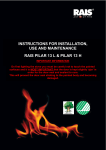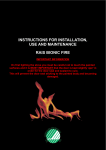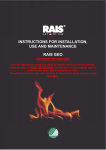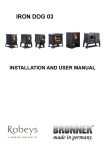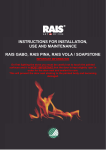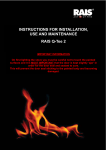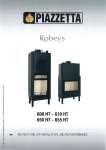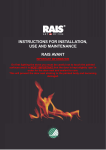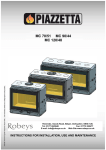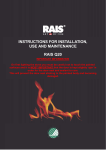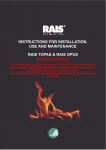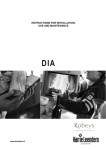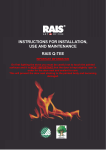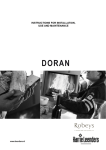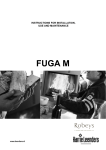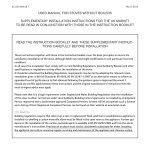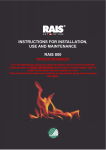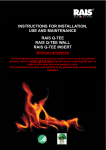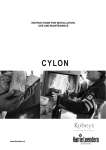Download instructions for installation, use and maintenance rais
Transcript
Manual for Rais Rina, Rais Viva & Rais Juno
INSTRUCTIONS FOR INSTALLATION,
USE AND MAINTENANCE
RAIS RINA, RAIS VIVA & RAIS JUNO
IMPORTANT INFORMATION
On first lighting the stove you must be careful not to touch the painted
surfaces and it is MOST IMPORTANT that the door is kept slightly ‘ajar’ in
order for the door seal and sealant to cure.
This will prevent the door seal sticking to the painted body and becoming
damaged.
1
September 2013
Manual for Rais Rina, Rais Viva & Rais Juno
2
September 2013
Manual for Rais Rina, Rais Viva & Rais Juno
Date
: 2012 Sept
HETAS SUPPLEMENT …………………………………………………….
MANUFACTURERS PLATE………………………………………………..
INTRODUCTION …………………………………………………………..
WARRANTY …………………………………………………….…………..
SPECIFICATIONS …………………………………………………………..
INSTALLATION INSTRUCTIONS ………………………………….………
CONVETION …………………………………………………………………
CHIMNEY ……………………………………….……………….………….
INSTALLATION …………………………….……………………..……...
CHANGING THE CHIMNEY CONNECTION ……………………………..
INSTALLATION DISTANCE ………………………………….……….......
FOR THE INSTALLER ………………………………………………………
OPERATING INSTRUCTIONS ……………………………………………..
FUEL …………………………………………………………………………...
DRYING AND STORAGE ……………………………………………………
REGULATION OF COMBUSTION AIR ……………………………………
ROOM VENTILATION AND STOVES ……………………………………..
LIGHTING AND FUELLING …………………………………………………
USING THE WOOD BURNING STOVE ……………………………………
FIRST USAGE …………………………………………………………………
CLEANING AND CARE ……………………………………………………..
CLEANING OF THE FLUE WAYS …………………………………………
PROBLEM SOLVING ………………………………………………………..
ACCESSORIES AND SPARE PARTS …………………………………….
SPARE PART DIAGRAM …….………..…………………………………….
INSTALLATION OF RINA SOAPSTONE ………………………………….
CERTIFICATE OF CONFORMITY ..…………………………………………
QUICK GUIDE …………………………………………………………………
SWIVEL BASE MOUNTING ………………………………………………….
3
4
9
11
11
12
13
14
14
15
17
18
25
26
26
28
28
28
29
31
31
33
33
34
35
36
50
51
52
53
September 2013
Manual for Rais Rina, Rais Viva & Rais Juno
SUPPLEMENTARY INSTALLATION INSTRUCTIONS FOR THE UK MARKET
TO BE READ IN CONJUNCTION WITH THOSE IN THE INSTRUCTION BOOKLET
READ THE INSTRUCTION BOOKLET AND THESE SUPPLEMENTARY
INSTRUCTIONS CAREFULLY BEFORE INSTALLATION
These instructions together with those in the instruction booklet cover the basic principles
to ensure the satisfactory installation of the stove, although detail may need slight
modification to suit particular local site conditions.
In all cases the installation must comply with current Building Regulations, Local Authority
Byelaws and other specifications or regulations as they affect the installation of the stove.
It should be noted that the Building Regulations requirements may be met by adopting the
relevant recommendations given in British Standards BS 8303, BS EN 15287-1:2007 as an
alternative means to achieve an equivalent level of performance to that obtained following the
guidance given in Approved Document J.
Please note that it is a legal requirement under England and Wales Building Regulations
that the installation of the stove is either carried out under Local Authority Building
Control approval or is installed by a Competent Person registered with a Government
approved Competent Persons Scheme. HETAS Ltd operate such a Scheme and a listing of
their Registered Competent Persons can be found on their website at www.hetas.co.uk.
CO Alarms:Building regulations require that when ever a new or replacement fixed solid fuel or wood/biomass
appliance is installed in a dwelling a carbon monoxide alarm must be fitted in the same room as the
appliance. Further guidance on the installation of the carbon monoxide alarm is available in BS EN
50292:2002 and from the alarm manufacturer’s instructions. Provision of an alarm must not be
considered a substitute for either installing the appliance correctly or ensuring regular servicing
and maintenance of the appliance and chimney system.
HEALTH AND SAFETY PRECAUTIONS
Special care must be taken when installing the stove such that the requirements of the Health and Safety at
Work Act are met.
Handling
Adequate facilities must be available for loading, unloading and site handling.
Fire Cement
Some types of fire cement are caustic and should not be allowed to come into contact with the skin. In
case of contact wash immediately with plenty of water.
Asbestos
This stove contains no asbestos. If there is a possibility of disturbing any asbestos in the course of
installation then please seek specialist guidance and use appropriate protective equipment.
Metal Parts
When installing or servicing this stove care should be taken to avoid the possibility of personal injury.
STOVE PERFORMANCE
In the UK the stove has been approved by HETAS Ltd as an intermittent operating appliance for burning wood
logs only.
PREPARATORY WORK AND SAFETY CHECKS
IMPORTANT WARNING
This stove must not be installed into a chimney that serves any other heating appliance.
There must not be an extractor fan fitted in the same room as the stove as this can cause the stove to emit
fumes into the room.
4
September 2013
Manual for Rais Rina, Rais Viva & Rais Juno
Chimney
For the stove to perform satisfactorily the chimney height must be sufficient to ensure an adequate draught
of approximately 15 Pa so as to clear the products of combustion and prevent smoke problems into the
room.
NOTE: A chimney height of not less than 4.5 metres measured vertically from the outlet of the stove to the
top of the chimney should be satisfactory. Alternatively the calculation procedure given in EN 13384-1 may
be used as the basis for deciding whether a particular chimney design will provide sufficient draught.
The outlet from the chimney should be above the roof of the building in accordance with the provisions of
Building Regulations Approved Document J.
If installation is into an existing chimney then it must be sound and have no cracks or other faults which
might allow fumes into the house. Older properties, especially, may have chimney faults or the cross section may be too large i.e. more than 230 mm x 230 mm. Remedial action should be taken, if required, seeking expert advice, if necessary. If it is found necessary to line the chimney then a flue liner suitable for solid
fuel must be used in accordance with Building Regulations Approved Document J.
Any existing chimney must be clear of obstruction and have been swept clean immediately before
installation of the stove. If the stove is fitted in place of an open fire then the chimney should be swept one
month after installation to clear any soot falls which may have occurred due to the difference in combustion
between the stove and the open fire.
If there is no existing chimney then either a prefabricated block chimney in accordance with Building
Regulations Approved Document J or a twin walled insulated stainless steel flue to BS 4543 can be used.
These chimneys must be fitted in accordance with the manufacturer’s instructions and Building
Regulations.
A single wall metal fluepipe is suitable for connecting the stove to the chimney but is not suitable for using
for the complete chimney. The chimney and connecting fluepipe must have a minimum diameter of 150 mm
and its dimension should be not less than the size of the outlet socket of the stove.
Any bend in the chimney or connecting fluepipe should not exceed 45°. 90° bends should not be used.
Combustible material should not be located where the heat dissipating through the walls of fireplaces or
flues could ignite it. Therefore when installing the stove in the presence of combustible materials due account must be taken of the guidance on the separation of combustible material given in Building
Regulations Approved Document J and also in these stove instructions.
If it is found that there is excessive draught in the chimney then a draught stabiliser should be fitted. Fitting
of a draught stabiliser will affect the requirement for the permanent air supply into the room in which the
stove is fitted in accordance with Approved Document J (see also combustion air supply).
Adequate provision e.g. easily accessible soot door or doors must be provided for sweeping the chimney
and connecting fluepipe where it is not intended for the chimney to be swept through the appliance, also to
permit visual checks on the integrity of the flue when the appliance is serviced.
Hearth
The hearth should be able to accommodate the weight of the stove and its chimney if the chimney is not
independently supported. The weight of the stove is indicated in the brochure.
The stove should always be installed on a non-combustible hearth of a size and construction that is in accordance with the provisions of the current Building Regulations Approved Document J.
The clearance distances to combustible material beneath, surrounding or upon the hearth and walls
adjacent to the hearth should comply with the guidance on the separation of combustible material given in
Building Regulations Approved Document J and also in these stove instructions.
If the stove is to be installed on a combustible floor surface, it must be covered with a noncombustible material at least 12mm thick, in accordance with Building Regulations
Ap-
5
September 2013
Manual for Rais Rina, Rais Viva & Rais Juno
proved Document J, to a distance of 30 cm in front of the stove and 15 cm to each side
measuring from the door of the combustion chamber
Combustion air supply
In order for the stove to perform efficiently and safely there should be an adequate air supply into the room
in which the stove is installed to provide combustion air. This is particularly necessary if the room is doubleglazed or a flue draught stabiliser is operating in the same room as the appliance. It may be necessary to
increase the air vent size in property with low air permeability ( < 5.0 m3 /(h.m2).
The provision of air supply to the stove must be in accordance with current Building Regulations Approved
Document J. An opening window is not appropriate for this purpose.
IMPORTANT NOTE: If applicable and the appliance is being fitted within an existing fireplace recess,
specialist advice should be sought before fitting any permanent ventilation within this area.
Connection to chimney
Stoves may have a choice of either a rear or top flue gas connector that allows connection to either a
masonry chimney or a prefabricated factory made insulated metal chimney in accordance with their
instructions. In some cases it may be necessary to fit an adaptor to increase the diameter of the flue to the
minimum required 150 mm section of the chimney or liner.
Electrical Services
The installation of any electrical services during the installation of this appliance must be carried out by a
registered competent electrician and in accordance with the requirements of the latest issue of BS 7671
Carbon Monoxide Alarm
A carbon monoxide alarm complying with BS EN 50292 must be fitted in the same room as the appliance. It
should be positioned on the ceiling at least 300mm from any wall or, if it is located on a wall, as high up as
possible (above any doors and windows) but not within 150mm of the ceiling. The alarm should also be between 1m and 3m horizontally from the appliance.
Commissioning and handover
Ensure loose parts are fitted in accordance with the instructions given in the instruction booklet.
On completion of the installation allow a suitable period of time for any fire cement and mortar to dry out,
when a small fire may be lit and checked to ensure the smoke and fumes are taken from the stove up the
chimney and emitted safely to atmosphere. Do not run at full output for at least 24 hours.
On completion of the installation and commissioning ensure that the operating instructions for the stove are
left with the customer. Ensure to advise the customer on the correct use of the appliance with the fuels
likely to be used on the stove and warn them to use only the recommended fuels for the stove.
Advise the user what to do should smoke or fumes be emitted from the stove. The customer should be
warned to use a fireguard to BS 8423:2002 in the presence of children, aged and/or infirm persons.
6
September 2013
Manual for Rais Rina, Rais Viva & Rais Juno
SUPPLEMENTARY OPERATING INSTRUCTIONS FOR THE UK MARKET
TO BE READ IN CONJUNCTION WITH THOSE IN THE INSTRUCTION BOOKLET
READ THE INSTRUCTION BOOKLET AND THESE INSTRUCTIONS
CAREFULLY BEFORE USING THE STOVE
WARNING NOTE
Properly installed, operated and maintained this stove will not emit fumes into the dwelling. Occasional
fumes from de‑ashing and re‑fuelling may occur. However, persistent fume emission is potentially
dangerous and must not be tolerated. In the event of fume emission from the appliance, then the following immediate action should be taken: ‑
(a)
(b)
(c)
(d)
Open doors and windows to ventilate room and then leave the premises
Let the fire go out
When safe to do so, check for flue or chimney blockage and clean if required
Do not attempt to relight the fire until the cause of the fume emission has been identified and corrected.
If necessary seek expert advice.
The most common cause of fume emission is flueway or chimney blockage. For your own safety these
must be kept clean at all times.
IMPORTANT NOTES
General
Before lighting the stove check with the installer that the installation work and commissioning checks described in the installation instructions have been carried out correctly and that the chimney has been swept
clean, is sound and free from any obstructions. As part of the stoves’ commissioning and handover the installer should have shown you how to operate the stove correctly.
CO Alarm
Your installer should have fitted a CO alarm in the same room as the appliance. If the alarm sounds
expectedly, follow the instructions given under “Warning Note” above.
un-
Use of fireguard
When using the stove in situations where children, aged and/or infirm persons are present a fireguard must
be used to prevent accidental contact with the stove. The fireguard should be manufactured in accordance
with BS 8423:2002 (Replaces BS 6539).
If the fire is left unattended a spark guard to BS 3248, specification for spark guards for use with solid fuel
appliances should be used.
Chimney cleaning
The chimney should be swept at least twice a year. It is important that the flue connection and chimney are
swept prior to lighting up after a prolonged shutdown period.
If the stove is fitted in place of an open fire then the chimney will require sweeping after a month of
continuous operation. This is a precaution to ensure that any “softer” deposits left from the open fire usage have
not been loosened by the higher flue temperatures generated by the closed stove.
In situations where it is not possible to sweep through the stove the installer will have provided alternative
means, such as a soot door. After sweeping the chimney the stove flue outlet and the flue pipe connecting
the stove to the chimney must be cleaned with a flue brush.
The Clean Air Act 1993 and Smoke Control Areas
Under the Clean Air Act local authorities may declare the whole or part of the district of the authority to be a
smoke control area. It is an offence to emit smoke from a chimney of a building, from a furnace or from any
fixed boiler if located in a designated smoke control area. It is also an offence to acquire an "unauthorised
fuel" for use within a smoke control area unless it is used in an "exempt" appliance ("exempted" from the
controls which generally apply in the smoke control area).
The Secretary of State for Environment, Food and Rural Affairs has powers under the Act to authorise
7
September 2013
Manual for Rais Rina, Rais Viva & Rais Juno
smokeless fuels or exempt appliances for use in smoke control areas in England. In Scotland and Wales
this power rests with Ministers in the devolved administrations for those countries. Separate legislation, the
Clean Air (Northern Ireland) Order 1981, applies in Northern Ireland. Therefore it is a requirement that fuels
burnt or obtained for use in smoke control areas have been "authorised" in Regulations and that appliances
used to burn solid fuel in those areas (other than "authorised" fuels) have been exempted by an Order
made and signed by the Secretary of State or Minister in the devolved administrations.
Rais Q-Tee, Rina, Viva, Juno, 500, 900, Epoca II, Poleo II, 900 and Q-Tee II
These have been recommended as suitable for use in smoke control areas when burning wood. The Q-Tee
models are fitted with a mechanical stop to prevent air closure beyond the 11.7mm open position. Note this
stop is factory fitted. The Q-Tee II model (only) is also approved for use with approved mineral fuels.
Further information on requirements of the Clean Air Act can be found at: http://smokecontrol.defra.gov.uk/
Your local authority is responsible for implementing the Clean Air Act 1993 including designation and supervision of smoke control areas and you can contact them for details of Clean Air Act requirements
Special Notes for use in a Smoke Control Area:
Refuelling on to a low fire bed:
If there is insufficient burning material in the firebed to light a new fuel charge, excessive smoke emission
can occur. Refuelling must be carried out onto a sufficient quantity of glowing embers and ash that the new
fuel charge will ignite in a reasonable period. If there are too few embers in the fire bed, add suitable
kindling to prevent excessive smoke
Fuel overloading:
The maximum amount of fuel specified in this manual should not be exceeded, overloading can cause
excess smoke.
Operation with door left open:
Operation with the door open can cause excess smoke. The appliance must not be operated with the
appliance door left open except as directed in the instructions.
Dampers left open:
Operation with the air controls or dampers open can cause excess smoke. The appliance must not be
operated with air controls or dampers left open except as directed in the instructions.
Periods of Prolonged Non-Use
If the stove is to be left unused for a prolonged period of time then it should be given a thorough clean to
remove ash and unburned fuel residues. To enable a good flow of air through the appliance to reduce condensation and subsequent damage, leave the air controls fully open.
Extractor fan
There must not be an extractor fan fitted in the same room as the stove as this can cause the stove to emit
smoke and fumes into the room.
Aerosol sprays
Do not use an aerosol spray on or near the stove when it is alight.
Use of operating tools
Always use the operating tools provided when handling parts likely to be hot when the stove is in use.
Chimney Fires
If the chimney is thoroughly and regularly swept, chimney fires should not occur. However, if a chimney fire
does occur turn off the stove immediately and isolate the mains electricity supply (if applicable), and tightly
close the doors of the stove. This should cause the chimney fire to go out. If the chimney fire does not go
out when the above action is taken then the fire brigade should be called immediately. Do not relight the
stove until the chimney and flueways have been cleaned and examined by a professional.
Permanent air vent
The stove requires a permanent and adequate air supply in order for it to operate safely and efficiently.
In accordance with current Building Regulations the installer may have fitted a permanent air supply vent
into the room in which the stove is installed to provide combustion air. This air vent should not under any
circumstances be shut off or sealed.
8
September 2013
Manual for Rais Rina, Rais Viva & Rais Juno
9
September 2013
Manual for Rais Rina, Rais Viva & Rais Juno
10
September 2013
Manual for Rais Rina, Rais Viva & Rais Juno
Introduction
Thank you for purchasing a Rais wood burning stove.
These appliances have been approved by SCA / HETAS as
intermittent operating appliances for burning wood logs only.
These appliances have been approved for use in Smokeless Zones
A Rais wood burning stove is more than just a heat source: it also shows that you
care about design and quality in your home.
To make the most of your wood burning stove it is important that you read the manual
thoroughly before installing and using it.
In the case of warranty coverage, and for general queries regarding your wood
burning stove, it is important that you know the stove’s production number.
We therefore recommend that you note down the number in the table below.
The production number is located at the back of the stove at the bottom.
Warranty
Your Rais wood burning stove comes with a 5 year warranty.
The warranty, however, does not cover heat-insulating materials, glass and seals.
These are available to order from your local Rais dealer / stockist.
Any alterations made to the stove will void the warranty.
11
September 2013
12
105
79
1.39
11
4
271
Weight (kg): ( Steel Door / Glass Door )
Efficiency ( % )
Particles after NS3058/3059 (g/kg)
Dust measured according to Din+ (mg/Nm3)
Smoke gas mass flow (g/s):
Smoke gas temperature (°C):
Fuelling should
be undertaken
within 3 hours
271
4
11
1.39
79
98
-12
1.2
295 / 225 / 393
320 / 225 / 393
Ø 440 / 980
Ca. 30-90
4.6
Viva 98
Viva 98 G
Fuelling should
be undertaken
within 3 hours
271
4
11
1.39
79
104
-12
1.2
295 / 225 / 393
320 / 225 / 393
Ø 440 / 1200
Ca. 30-90
4.6
Viva 120
Viva 120 G
Please Note, this appliance has been tested by the manufacturers and works on a 3m straight flue.
Fuelling should
be undertaken
within 3 hours
-12
Min. uptake / Min. draught (Pascal):
Intermittent operation:
1.2
295 / 225 / 393
Combustion chamber width/depth/height (mm).
Recommended amount of wood when fuelling (kg)
(Based on 2 - 3 logs of wood approx. 25cm)
461 / 410 / 900
Ca. 30-90
4.6
Size, width/depth/height (mm):
Heating area (m2):
Nominal output (kW):
Rina 90
Fuelling should
be undertaken
within 3 hours
271
4
11
1.39
79
356
-12
1.2
295 / 225 / 393
320 / 225 / 393
Ø 470 / 1660
Ca. 30-90
4.6
Rais Juno
Rais Juno G
Specifications
Manual for Rais Rina, Rais Viva & Rais Juno
September 2013
Manual for Rais Rina, Rais Viva & Rais Juno
13
September 2013
Manual for Rais Rina, Rais Viva & Rais Juno
14
September 2013
Manual for Rais Rina, Rais Viva & Rais Juno
15
September 2013
Manual for Rais Rina, Rais Viva & Rais Juno
16
September 2013
Manual for Rais Rina, Rais Viva & Rais Juno
17
September 2013
Manual for Rais Rina, Rais Viva & Rais Juno
18
September 2013
Manual for Rais Rina, Rais Viva & Rais Juno
19
September 2013
Manual for Rais Rina, Rais Viva & Rais Juno
20
September 2013
Manual for Rais Rina, Rais Viva & Rais Juno
21
September 2013
Manual for Rais Rina, Rais Viva & Rais Juno
22
September 2013
Manual for Rais Rina, Rais Viva & Rais Juno
23
September 2013
Manual for Rais Rina, Rais Viva & Rais Juno
24
September 2013
Manual for Rais Rina, Rais Viva & Rais Juno
25
September 2013
Manual for Rais Rina, Rais Viva & Rais Juno
26
September 2013
Manual for Rais Rina, Rais Viva & Rais Juno
27
September 2013
Manual for Rais Rina, Rais Viva & Rais Juno
28
September 2013
Manual for Rais Rina, Rais Viva & Rais Juno
Lighting and fuelling "Top-Down" lighting
Start by placing 3-4 pieces wood - approx. 1 ½ - 2 kilogram - in the bottom of the
burning chamber.
Place approx. 1 kilogram of dry firewood, split into kindling sticks., and a couple of
alcohol briquettes or similar (1-2).
Set the air damper to fully open position.
Light the fire and close the door (3-4).
When the flames are clear - after approx. 10-15 min - close the door completely
(5). Damper - see adjustment of air damper.
When the last flames are extinguished and there is a nice layer of embers (5), add
2-3 pieces of wood.
Close the door and once the fire has a good hold closed door completely. Damper
- see adjustment of air damper.
After approx. 5 min - or when the flames are clear and stable (6) - close the
damper gradually.
Note!!!
Keep an eye on the stove when lighting.
During operation the door should always remain shut.
29
September 2013
Manual for Rais Rina, Rais Viva & Rais Juno
30
September 2013
Manual for Rais Rina, Rais Viva & Rais Juno
31
September 2013
Manual for Rais Rina, Rais Viva & Rais Juno
32
September 2013
Manual for Rais Rina, Rais Viva & Rais Juno
33
September 2013
Manual for Rais Rina, Rais Viva & Rais Juno
Problem solving
Smoke spillage around door:
- could be due to too low draught in the chimney <12Pa
- check if the flue or chimney is blocked
- check if a extraction hood is switched on; if it is, switch it off and open a window/door in
the proximity of the stove for a short while.
Soot on glass:
- could be because the firewood is too wet.
- make sure that the stove is heated properly when firing up, prior to closing the door
- could be because the damper regulation is too low.
A stove burning too strong could be caused by:
- a leak around the door seal
- chimney draught too large >22 Pa, draught control regulator should be installed.
A stove burning too weakly could be caused by:
- too little firewood
- too little air supply for the room ventilation
- dirty smoke channels
- leaking chimney
- leakage between chimney and flue
If your stove continues to malfunction, we recommend that you contact your RAIS
distributor or chimney sweep.
IMPORTANT!!
To ensure safe burning there must be clear yellow flames or clear embers at all times. The
firewood should not be smouldering. Therefore you should never completely cut off the air
supply.
WARNING!!
In case of chimney fire:
- shut off all air supply on the wood burning stove
- contact the fire services
- never attempt to put out fire with water!
- afterwards, you should ask your chimney sweep to check the stove and chimney
34
September 2013
Manual for Rais Rina, Rais Viva & Rais Juno
35
September 2013
Manual for Rais Rina, Rais Viva & Rais Juno
36
September 2013
Manual for Rais Rina, Rais Viva & Rais Juno
37
September 2013
Manual for Rais Rina, Rais Viva & Rais Juno
38
September 2013
Manual for Rais Rina, Rais Viva & Rais Juno
39
September 2013
Manual for Rais Rina, Rais Viva & Rais Juno
40
September 2013
Manual for Rais Rina, Rais Viva & Rais Juno
41
September 2013
Manual for Rais Rina, Rais Viva & Rais Juno
42
September 2013
Manual for Rais Rina, Rais Viva & Rais Juno
43
September 2013
Manual for Rais Rina, Rais Viva & Rais Juno
44
September 2013
Manual for Rais Rina, Rais Viva & Rais Juno
45
September 2013
Manual for Rais Rina, Rais Viva & Rais Juno
46
September 2013
Manual for Rais Rina, Rais Viva & Rais Juno
47
September 2013
Manual for Rais Rina, Rais Viva & Rais Juno
48
September 2013
Manual for Rais Rina, Rais Viva & Rais Juno
49
September 2013
Manual for Rais Rina, Rais Viva & Rais Juno
50
September 2013
Manual for Rais Rina, Rais Viva & Rais Juno
51
September 2013
Manual for Rais Rina, Rais Viva & Rais Juno
52
September 2013
Manual for Rais Rina, Rais Viva & Rais Juno
53
September 2013
Manual for Rais Rina, Rais Viva & Rais Juno
U K Distributor.
Robeys Ltd.
Riverside, Goods Road, Belper,
Derbyshire, England. DE56 1UU
Tel: 01773 820940 Fax: 01773 820477
E Mail: [email protected]
www.robeys.co.uk
October 2011
54
September 2013






















































